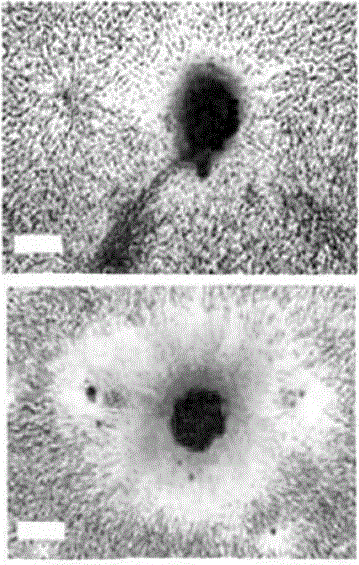Resuscitation fluid applied to vitrified cryopreserved mesenchymal stem cells
A bone marrow mesenchymal, vitrification cryopreservation technology, applied in the field of cryopreservation and resuscitation fluid, can solve the problems of reducing the recovery rate of cryopreserved cells, penetrant damage of protective agents, cytotoxic damage, etc., to promote the differentiation and growth of stem cells, reduce Cytotoxic damage, the effect of reducing the content
- Summary
- Abstract
- Description
- Claims
- Application Information
AI Technical Summary
Problems solved by technology
Method used
Image
Examples
Embodiment 1
[0029] Such as figure 1 As shown, a resuscitation solution for vitrification of bone marrow mesenchymal stem cells, including 20% human serum albumin, 0.8% monosaccharide, 0.21% cell growth factor, 1.5% hydroxyethylpiperazine Sulfuric acid, 0.8% non-essential amino acids, 0.08% L-glutamine, 0.03% β-mercaptoethanol, and the rest are normal saline.
[0030] Experimental cryopreservation materials: animal, 2-year-old Beagle dog, male, weighing 22.7kg.
[0031] experimental method:
[0032] Step 1: Extract bone marrow, purify and isolate mononuclear cells, inoculate and culture the primary cells for 48 hours, and inoculate them with 10 mmol / L of dexamethasone, 2.16 g / L of β-glyceroglycerophosphate and 37.5 mg / L of 2 - Ascorbic acid phosphate culture medium, 5% CO 2 In an incubator, culture at 37°C for 8 days; use 0.25% trypsin-0.02% EDTA culture solution for the first passage; use 1.6×10 4 / cm 2 The cell density was inoculated and cultured to the P2 generation.
[0033] St...
Embodiment 2
[0043] A resuscitation solution for vitrification of bone marrow mesenchymal stem cells, including 20% human serum albumin, 1% monosaccharide, 0.23% cell growth factor, 1.5% hydroxyethylpiperazineethanesulfonic acid, 1.2% non-essential amino acids, 0.12% L-glutamine, 0.04% β-mercaptoethanol, and the rest are normal saline.
[0044] Experimental cryopreservation materials: animal, 2-year-old Beagle dog, male, weighing 22.7kg.
[0045] experimental method:
[0046]Step 1: Extract bone marrow, purify and isolate mononuclear cells, inoculate and culture the primary cells for 48 hours, and inoculate them with 10 mmol / L of dexamethasone, 2.16 g / L of β-glyceroglycerophosphate and 37.5 mg / L of 2 - Ascorbic acid phosphate culture medium, 5% CO 2 In an incubator, culture at 37°C for 8 days; use 0.25% trypsin-0.02% EDTA culture solution for the first passage; use 1.6×10 4 / cm 2 The cell density was inoculated and cultured to the P2 generation.
[0047] Step 2: Completely immerse t...
Embodiment 3
[0057] A resuscitation solution for vitrification of bone marrow mesenchymal stem cells, including 20% human serum albumin, 0.9% monosaccharide, 0.22% cell growth factor, 1.5% hydroxyethylpiperazine ethanesulfonic acid, 1.1% non-essential amino acids, 0.1% L-glutamine, 0.032% β-mercaptoethanol, and the rest are normal saline.
[0058] Experimental cryopreservation materials: animal, 2-year-old Beagle dog, male, weighing 22.7kg.
[0059] experimental method:
[0060] Step 1: Extract bone marrow, purify and isolate mononuclear cells, inoculate and culture the primary cells for 48 hours, and inoculate them with 10 mmol / L of dexamethasone, 2.16 g / L of β-glyceroglycerophosphate and 37.5 mg / L of 2 - Ascorbic acid phosphate culture medium, 5% CO 2 In an incubator, culture at 37°C for 8 days; use 0.25% trypsin-0.02% EDTA culture solution for the first passage; use 1.6×10 4 / cm 2 The cell density was inoculated and cultured to the P2 generation.
[0061] Step 2: Completely immer...
PUM
 Login to View More
Login to View More Abstract
Description
Claims
Application Information
 Login to View More
Login to View More - R&D
- Intellectual Property
- Life Sciences
- Materials
- Tech Scout
- Unparalleled Data Quality
- Higher Quality Content
- 60% Fewer Hallucinations
Browse by: Latest US Patents, China's latest patents, Technical Efficacy Thesaurus, Application Domain, Technology Topic, Popular Technical Reports.
© 2025 PatSnap. All rights reserved.Legal|Privacy policy|Modern Slavery Act Transparency Statement|Sitemap|About US| Contact US: help@patsnap.com

